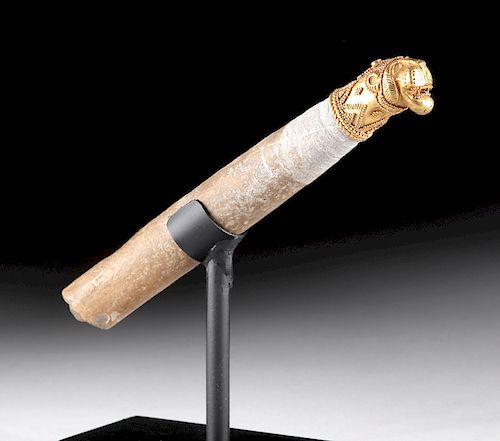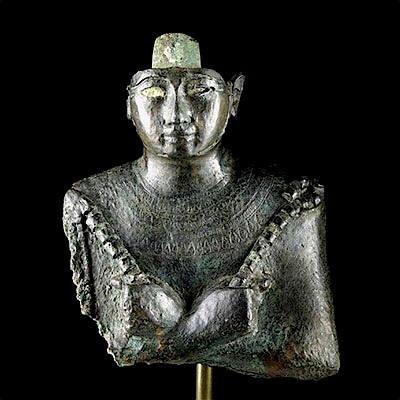Western Asiatic / Achaemenid Gold Lion Finial on Stone
Lot 74
About Seller
Artemis Fine Arts
686 S Taylor Ave, Ste 106
Louisville, CO 80027
United States
Selling antiquities, ancient and ethnographic art online since 1993, Artemis Gallery specializes in Classical Antiquities (Egyptian, Greek, Roman, Near Eastern), Asian, Pre-Columbian, African / Tribal / Oceanographic art. Our extensive inventory includes pottery, stone, metal, wood, glass and textil...Read more
Estimate:
$5,000 - $7,000
Absentee vs Live bid
Two ways to bid:
- Leave a max absentee bid and the platform will bid on your behalf up to your maximum bid during the live auction.
- Bid live during the auction and your bids will be submitted real-time to the auctioneer.
Bid Increments
| Price | Bid Increment |
|---|---|
| $0 | $25 |
| $300 | $50 |
| $1,000 | $100 |
| $2,000 | $250 |
| $5,000 | $500 |
| $10,000 | $1,000 |
| $20,000 | $2,500 |
| $50,000 | $5,000 |
| $100,000 | $10,000 |
| $200,000 | $20,000 |
About Auction
By Artemis Fine Arts
May 22, 2019
Set Reminder
2019-05-22 10:00:00
2019-05-22 10:00:00
America/New_York
Bidsquare
Bidsquare : Exceptional Day 1: Antiquities Asian Fine Art
https://www.bidsquare.com/auctions/artemis-gallery/exceptional-day-1-antiquities-asian-fine-art-4129
Day 1 of an important 2-day auction featuring exceptional art from around the world - Egyptian, Greek, Etruscan, Roman, Viking, Russian, Near Eastern; Asian Art from China, Japan, Thailand, Vietnam, Burma, India; Fine Art from the 17th century to present. Artemis Fine Arts info@artemisfinearts.com
Day 1 of an important 2-day auction featuring exceptional art from around the world - Egyptian, Greek, Etruscan, Roman, Viking, Russian, Near Eastern; Asian Art from China, Japan, Thailand, Vietnam, Burma, India; Fine Art from the 17th century to present. Artemis Fine Arts info@artemisfinearts.com
- Lot Description
Ancient Western Asiatic or Achaemenid Empire, ca. 5th century BCE. A most impressive gold finial (comprised of 88% gold, equivalent to 20K+) depicting the head of a lion, with facial features finely delineated in repousse, his mouth open as if roaring and brandishing many gold granules to represent teeth and fangs, stipples on the cheeks, a double band of granules with a triangular centerpiece over the forehead, bands of granules surrounding the neck and ears, a granulated star between the ears with a blue glass inlay at the center, and on the neck, an impressive ensemble of granules arranged in zigzag, diamond, and triangular motifs. Finally, two filagreed rope-patterned bands serve as a back border. The finial is mounted to an ancient stone tubular component and set upon a museum-quality stand. Size: finial measures 1.125" L x .625" in diameter (2.9 cm x 1.6 cm); 4.125" H (10.5 cm) on included custom stand. Ceramic rod measures 5.125" L (13 cm)
The Achaemenid Persian Empire, founded by Cyrus the Great in 550 BCE (including Iran, Mesopotamia, Syria, Egypt, Asia Minor, Central Asia, Caucasus, Thrace and some parts of India) is generally regarded as one of the greatest civilizations of the ancient world. Its capital, Pasargadae, was Cyrus the Great's final resting place and has been named a UNESCO World Heritage Site. To demonstrate the Achaemenid Empire's love of gold, associates of Alexander the Great in accounts of a tomb in Pasargadae, described a golden sarcophagus, necklaces, and gold gemstone earrings. The tomb is located in Pasargadae, in the garden of a royal palace where an ensemble of artifacts known as the Pasargadae Treasure - including various articles of gold and silver, jewelry and gemstones - were found in a ceramic amphora.
The Achaemenid love of silver and gold was famous throughout the ancient world. Plato wrote of how the acquisition of gold and silver was considered a virtue while Alcibiades, another Athenian, wrote of the enormous wealth in gold and silver that the Persians had. Ancient Greek writers described the impressive wealth of the Persians. To quote Herodotus when speaking of Xerxes' troops, they "were adorned with the greatest magnificence …. They glittered all over with gold, vast quantities of which they wore about their persons." (Vii. 83).
Provenance: private New York, USA collection; acquired at Palmyra Heritage auction, New York City, USA, June 10, 2017; ex The Sumer Collection, Mr. Ben Anavian, California, USA
All items legal to buy/sell under U.S. Statute covering cultural patrimony Code 2600, CHAPTER 14, and are guaranteed to be as described or your money back.
A Certificate of Authenticity will accompany all winning bids.
We ship worldwide and handle all shipping in-house for your convenience.
#145404Minute indentations (possibly casting flaws) to chin. A few missing granules, but most are present. Normal surface wear and loss to end of stone rod to which the finial is fitted.Condition
- Shipping Info
-
All shipping is handled in-house for your convenience. Your invoice from Artemis Gallery will include shipping calculation instructions. If in doubt, please inquire BEFORE bidding for estimated shipping costs for individual items.
-
- Buyer's Premium



 EUR
EUR CAD
CAD AUD
AUD GBP
GBP MXN
MXN HKD
HKD CNY
CNY MYR
MYR SEK
SEK SGD
SGD CHF
CHF THB
THB















